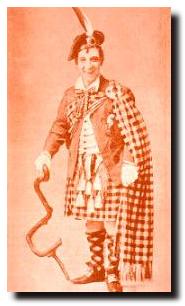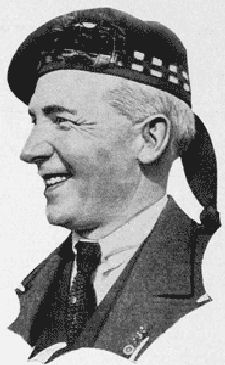Member Login
Free Search
Enter First Name, Last Name or Full Name and click Search,or click on the Advanced Search link for more options
Famous Scots - Harry Lauder


Born Henry Lauder at 4 Bridge Street, Portobello, Edinburgh, (then the residence of his mother’s father) on the 4th August 1870. He was the eldest son of John Currie Lauder (1851-1882) (who had been born in nearby Musselburgh) a Master Potter and a descendant of Lauder & Bass, and Isabella Urquhart MacLeod McLennan (1854 -1905) born in Arbroath but whose family originated in the Black Isle in Rossshire.
Harry’s family had been relatively comfortable. His great grandfather, George Lauder (1776-1824), had been the tenant farmer at Inverleith Mains and a local landholder in nearby Stockbridge, Edinburgh. Amongst his properties was the famous St. Bernard’s Well. This remained in the family until later that century. Harry’s grandfather, John Lauder (1818-1888), too had owned a large house at 4 Rose Street, Edinburgh, the site of which is now occupied by the rear of Jenners famous department store. The family were therefore in a position to afford the boys of the family apprenticeships in a variety of trades. One of Harry’s grandfather’s brothers had been a baker, another a plumber.
Harry’s father did his apprenticeship in the Portobello pottery, which itself was of some note, and was held in some considerable repute. He was later offered an excellent position at Pearson’s Pottery at Newbold near Chesterfield, Derbyshire, which he accepted. However, after being there only a short time he contracted pneumonia and died aged only 32. He was buried in the Newbold Churchyard in 1882 and his widow removed back to Arbroath with her family. Most children were then leaving the infant State sector schools to work in factories but Harry's mother was determined that his schooling should continue. So in order to attend the school at the nearby flax mill, Harry took a part-time job there, which also assisted the large family’s income (there were eight children, one of whom was born posthumously).
Harry’s mother’s brother, Alexander (Sandy) was working in Hamilton, Lanarkshire, where there was enormous industrial activity at that time and towards the end of the decade Isabella, encouraged by her brother, moved to Hamiltonwhere the three eldest lads, Harry, Matthew and John obtained work in the local coal mines. This they did for about nine to ten years. Matt studied in his spare time and obtained an under-manager’s certificate while John emigrated first to New Zealandand then Kurri Kurri in New South Wales. Harry determined to leave the mines and his career as an entertainer from this point is well known.
Matt became a mining consultant until the end of the First World War, travelling throughout the world from the beginning of the century. His purchase then of a landscaping business in Californiameant that he would henceforth spend most of his time there until his death.
On 19th June 1891Harry, as he became known, married Ann (Nance), eldest daughter of James Limerick Vallance (1855-1936) a Colliery Manager at Hamilton, Lanarkshire, and Mary Kerr (1856-1937). Matt, Harry’s brother, was Best Man. The following year Matt married Ann’s sister Catherine Swanstone Limerick Vallance, and Harry was his Best Man! (James Vallance’s father had changed his name from Limerickto Vallance before dying in the Crimean War).
There can be no doubt whatever of Harry Lauder’s tremendous popularity. He toured the world for forty years including 22 times to the U.S.A., and several times to Australiawhere he often stayed with his brother John. Harry and his wife and son were in Melbourne, Victoria, when the British Empiremobilised for World War One. Sir Winston Churchill referred to Harry as "Scotland’s greatest ever ambassador". Harry was the first British entertainer to sell a million records and was a favourite of King Edward
A robust patriot, Harry raised huge sums of money for war charities during the Great War (1914-1918) and entertained troops in the trenches in France, where he came under enemy fire. He was knighted in January 1919 by King George V. He again entertained troops, and broadcasted over the wireless with the BBC Scottish Symphony Orchestra during World War II, despite his advanced years. Even towards the end of that conflict and just afterwards Sir Harry appeared at the docks when American food ships came into Glasgowto publicly thank the crews for coming to Britain’s assistance in her hour of need.
Sir Harry wrote most of his own songs, favourites of which were Roamin in the Gloamin’, I Love a Lassie, A Wee Deoch-an-Doris, and Keep Right on to the End of the Road, and starred in three British films: Huntingtower (1928), Auld Lang Syne (1929) and The End of the Road (1936).
He also wrote a number of books which ran into several editions, including Harry Lauder at Home and on Tour (1912), A Minstrel in France (1918), Roamin’ in the Gloamin’ (1927 autobiography), My Best Scotch Stories (1929), Wee Drappies (1931) and Ticklin’ Talks (c.1932). Sir Harry mentions his descent from the Lauders of Lauder and Bass in his autobiography.
Sir Harry’s only child, John (b.19th November 1891) had attended the City of London School and CambridgeUniversityand was destined for a career in law. However, he was called up and Captain John Lauder of the 8th Argyll and Sutherland Highland Regiment, was eventually killed at Poiziers in Franceon 26th December 1916and was buried the following month in the AlbertRoadCemeteryat Orvilliers, France. He was unmarried.
A monument was erected by his father in the tiny family graveyard at Glenbranter in Argyll. Young John’s mother and her parents are buried next to his memorial.
Sir Harry’s wife Anne also sadly died on 31st July 1927, a terrible blow to the great man. His youngest brother, Alexander, had a daughter, Margaret [Greta] (1900-1966), who was fond of Sir Harry and she moved in to keep an eye on him at his beautiful mansionof Laudervaleoutside Dunoon. She was to become his almost inseparable companion.
In 1932 Sir Harry purchased the property at Strathaven, Lanarkshire, where his next mansion, Lauder Ha’ was constructed for, as he would say, a home for all the family; and a memorial to his fame. Cleverly, he put the land in his niece’s name to avoid death duties when he passed away. She would stay there until her untimely death aged 66.
Sir Harry Lauder died at Lauder Ha’ on the 26thFebruary 1950. At his funeral service the Lesson was read by the Duke of Hamilton, and all shops and businesses in Hamilton closed for the day. Sir Harry was unexpectedly interred not with his wife at Glenbranter, but with his mother, and brother George, in Bent Cemetery, Hamilton, after that town’s most memorable funeral ever. It was covered by Pathe News and wreaths were received from all over the world, including one from Queen Elizabeth (Queen Mother) and another from Mr & Mrs Winston Churchill.
Video link http://www.britishpathe.com/record.php?id=40810
Headstone Photograph

Further Information
Title: Sir
Firstname: HARRY
LastName: LAUDER
Date of Death: 26th Feb 1950
Cemetery: Bent Cemetery
Bent Road
Town: Hamilton
PostCode: ML3 6PY
Region: Glasgow and Clyde Valley
Country: Scotland
Please Note, the marker on this map indicates the Cemetery location, not the location of a particular grave.



